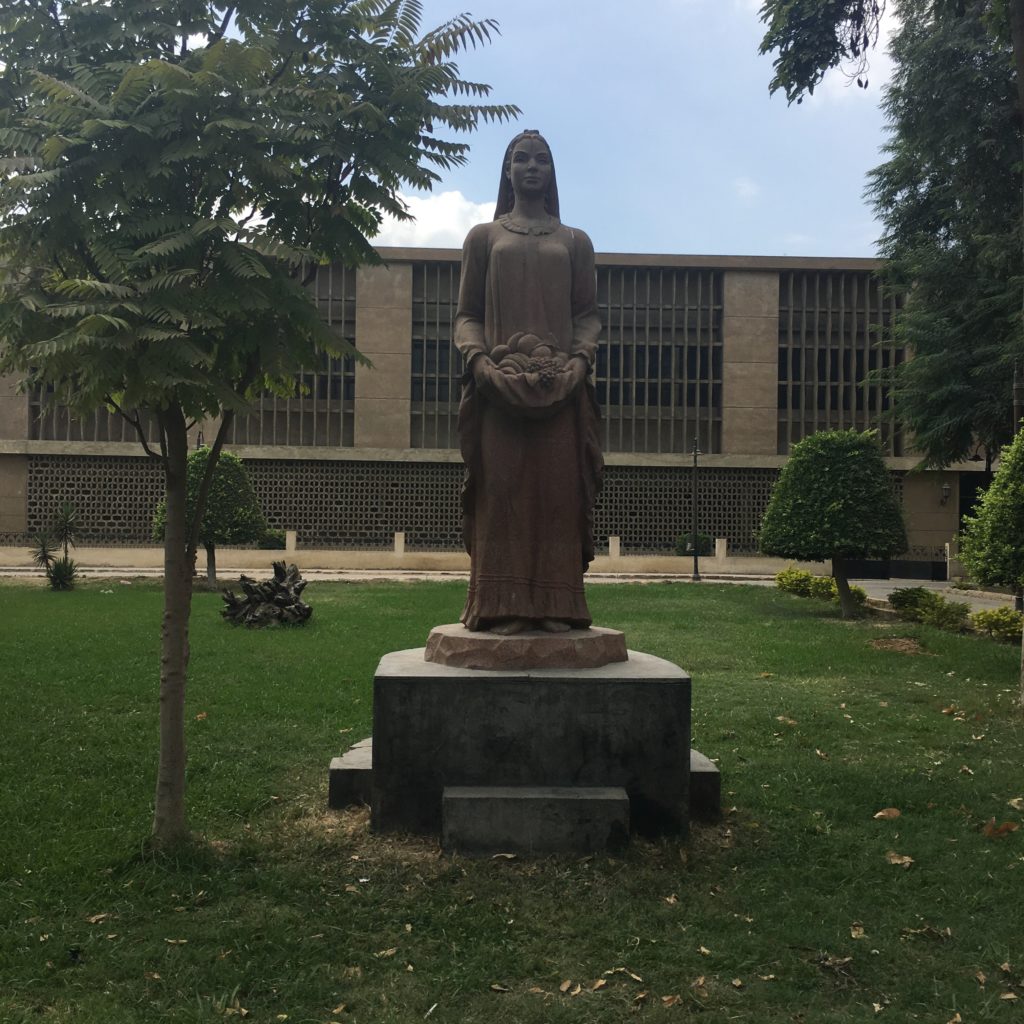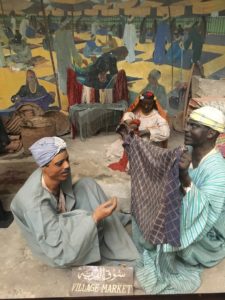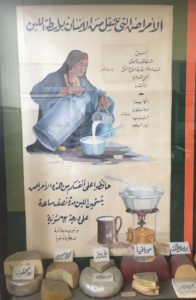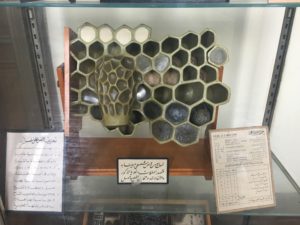By Taylor Moore

The Cairo Agricultural Museum complex, located right off of Salah Salem street in the neighborhood of Dokki, is a gem of object collections and archival holdings hidden in plain sight. Its under-utilized collections will be of interest to historians and social scientists working on agriculture, food, natural history, political economy, rural Egyptian history, and public works from the Pharaonic period until present day. The museum is also a rare find for scholars interested in material culture and museum studies in modern Egypt. Its exhibits stand as an archive in and of themselves. They provide material testament to developments in the natural sciences, anthropology, food science, visual culture, and curatorial practices as many of the collections and dioramas remain untouched since the first half of the twentieth century.
History
In 1930, King Fouad of Egypt established the Agricultural Museum in the Cairo suburb of Dokki in the palace of Princess Fatima, the daughter of the great Khedive Ismail. It is one of the first agricultural museums in the world—second only to the Royal Agricultural Museum in Budapest. The museum was officially inaugurated by King Farouk in 1938 when he selected the venue to host 18th International Cotton Congress. The Agriculture Museum was preceded by an array of agricultural expositions organized by the Khedival Agricultural Society (later Royal Agricultural Society), an organization determined to improve agricultural methods in Egypt, and “the lot of the fellah.” The society created a small agricultural museum in 1920. This initial collection was ultimately modified into a cotton museum, which later became a part of the “Fouad I Agricultural Museum” when it opened to the public (el Shakry, 2007).
The Museum’s initial collections consisted of an array of objects donated from scientific institutions throughout Egypt, including the Royal Geographical Society, the Royal Agricultural Society, and the Egyptian Department of Antiquities. Hungarian artists oversaw the creation and curation of the museum’s first displays (Davies 2014). With its holdings “lying halfway between a museum of natural history and a purely agricultural museum,” the Egyptian government mobilized the museum as cultural and educational space for the public until the 1960s (Ghawas, 1972). For the next thirty odd years, the museum was essentially left for dead. Most of its artifacts and object collections were relocated to storage, and the exhibition halls were transformed into makeshift government offices, presumably for Ministry of Agriculture staff. In the 1990s, restoration projects began in earnest. As they were completed, sections of the museum were slowly reopened to the public beginning with the Hall of Ancient Egyptian Agriculture and the Cotton Museum in 1996. Currently, the museum complex is composed of seven exhibition halls (the museum pamphlet refers to these entities as small museums, or mutahif), a library, research laboratories, greenhouses, and a cinema. The grounds surrounding the museum have been maintained as a beautiful garden space, with two Pharaonic-style gardens located near the entrance to the Hall of Ancient Egyptian Agriculture.
Collections
As mentioned above the Cairo Agricultural Museum boasts seven exhibition halls which depict varying topics in natural history and agricultural science. The majority of the museum’s labels are in Arabic, however some exhibits provide English translations.
1. Scientific Collections

The Scientific Collections Hall is the oldest in the museum. The first floor is dedicated to ethnographic materials that depict the social and economic lives of the Egyptian fellahin. The most stunning exhibits of this building are the large, life-size dioramas of a rural wedding procession, and a village souk complete with a community forn, a café with galabiyya-wearing men laughing while smoking shisha, and even a female fortune teller reading shells. There are also rooms specializing in rural handicrafts, “habits and customs,” and the High Dam. The second floor houses a large natural history collection of taxidermy animals native to Egypt and Sudan, with rooms specializing in the life-cycles of domestic farm animals, insects and crop pests, as well as a room of popular Egyptian products and manufactured food goods from the 1940s and 1950s.

2. Botanical Revolution Hall
This hall, also referred to as the “Plant Kingdom Museum,” was established in 1935. Its
exhibits depict Egypt’s field crops, horticultural and garden plants, and popular agricultural machinery. The first floor specializes in grain crops such as wheat, barley, corn, and rice, and also has a room on onions and garlic. The second floor specializes in fiber crops, and rooms on fruits, vegetables, legumes, and more.
3. The Cotton Museum
In many aspects the original collection of the Agricultural Museum, the Royal Agricultural Society organized the Cotton Museum in 1920, and opened it to the public in 1926. The collections in their most recent state were inaugurated in the Cairo Agricultural Museum in 1996 on Eid el Fellah (a feast day commemorating the victories of the peasantry and the implementation of Nasserist agricultural reforms after the 1952 revolution). The collections explore the importance of the cotton crop over the long duree of Egyptian history in its many forms from field to finished product, and include rare cotton the seeds and fibers from varying species of cotton crop grown around the world.
4. Ancient Egyptian Agriculture
This collection highlights role of the Nile River and the importance of agriculture in the economic, social, and spiritual realms of Pharaonic civilization. Many of these collections were acquired between 1932 and 1938 as donations from the Egyptian Museum and the Egyptian Department of Antiquities. Cappers and Hamdy (20007) provide original catalogue entries for specimen in this collection as well as some in the “Greek, Coptic, and Islamic” collections below.
5. Agriculture in Greek, Roman, Coptic, and Islamic Periods
These collections represent the second stage of development in early Egyptian agriculture
from 332 BC, when Alexander the Great conquered Egypt, until the rule of Mohammed
(Mehmet) Ali Pasha in 1805. However, the majority of materials are concentrated in the Greek and Roman periods. They highlight the role of plants in society (from popular field crops to medicine), the raising of livestock, and the social lives of the peasant classes at in these periods.

6. The Syrian Hall
This exhibit, inaugurated on July 31, 1961 commemorates Egypt and Syria’s short-lived union in the form of the United Arab Republic from 1958 to 1961. Its contents include information on trade between the two countries, and provide a collection of Syrian handicrafts, produce, and rural life.
7. The Egypt-China Friendship Exhibition
Opened in 2013, this exhibit is composed mostly of art and ceramics donated from China
to illustrate the thriving political relationship between Egypt and China.
8. Library
The museum’s library is a quaint two-floor building with an array of books, periodicals, and maps ranging from the mid-nineteenth century until the early 2000s. The subjects of the collection focus on a variety of agriculture and “agriculture-adjacent” materials such as botany, horticulture, public works, livestock, geography, and the social and economic aspects of rural life. Some examples of publications held in the library include volumes of Mémoires Présentés à l’Institut d’Egypte from the 1880s until the 1930s, yearly reports from the Department of Public Works from the 1880s onwards, and a Ministry of Agriculture periodical entitled Zamīl al-Fallāḥ published in the 1930s. Certain publications of the Ministry of Agriculture can also be found here, however most of those materials are held in the library of the Ministry of Agriculture and the National Agricultural Library (both located down the street from the Agricultural Museum.) As far as I know, this collection has not been catalogued and I was only able to conduct a cursory survey of the holdings during my research there. Future researchers may find more than detailed in this review.
Research Experience
The Agricultural Museum and Library is easily accessible to researchers. Those that speak Arabic will have an easier time of things, although many of the museum and library staff know some level of English. As of 2016, the entry fee to the main collection halls, library, and gardens was 5 LE, with an extra fee to enter the Hall of Ancient Egyptian Agriculture. However, researchers must note that depending on the day, and maybe even the hour, particular halls or exhibitions may be locked and/or closed to visitors. Generally, the main exhibits in the natural history, or scientific collections, and the library are always open to the public.
The library, located near the research laboratories a ways off from the main buildings, is a charming and pleasant workspace. More often than not, researchers will have the reading room to themselves, sharing the space with only a handful of library staff. Madame Azza is the main librarian. After signing your name in a logbook, Madame Azza will ask you what kinds of materials you are interested in. You can give her specific texts or vague subject and she will bring the exact text, or texts that might interest you out to the reading room for you. If you are lucky, she may allow you to wonder through the upstairs stacks yourself. This is the area where most of the old periodicals, governmental reports, and “rare books” from 1880 until 1950 are housed.

Currently, there is neither known catalogue for the ethnographic and natural history collections, nor the holdings in the library. I was also not able to find information on the provenance of the museum’s collections. However, as of June 25 2017 the Egyptian Central Department of Archaeological Acquisitions examined and registered over 1,000 of the Agricultural museum’s ancient animal and geological artifacts. There may be a way to access the catalogue or reports from this investigation. Those wishing to work with certain objects or collections should get in touch with the museum staff directly. Although the museum’s pamphlet provides a phone number and an email address for researchers to direct their inquiries, it is recommended that scholars make requests in person to the museum staff who may put you in touch with the museum director. It is advised that researchers provide a statement in Arabic addressing their academic affiliation, research interests, and the collections they are interested in working with.
Unlike other archives in Egypt, such as Dar al-Watha’iq al-Qawmiyya (The Egyptian National Archives) and Dar al-Kutub (The Egyptian National Library) where photographs of materials are forbidden, or in the Egyptian Geographical Society’s Ethnographic Museum where photographs of the exhibits can be taken for a fee, the Cairo Museum of Agriculture allows researchers to take pictures of materials in both the library and the museum for free.
Transportation
The Cairo Agricultural Museum is located in the neighborhood of Dokki. The museum is an easy 25 minute walk from the Behouth (Dokki) or the Opera (Zamalek) metro stations. Given the museum’s location right off of Salah Salem, it is easily accessible via taxi, Uber, or Kareem as well. Researchers can simply direct them to “al-mathaf al-zara’i” or “wizarat al-zira’a.” There are a handful of restaurants, cafes, and kushks located near the museum, particularly in the directions of the Dokki Shooting Club (Nadi Es-Sid) and Mohandessin.
Contact Information (according to museum pamphlet):
Telephone: +2(02)33372933 and +2(02)37616874
Website: www.agrimuseum.gov.eg
Email: agri.museum@yahoo.com
Hours: Sunday through Friday 9AM-2PM; The museum is occasionally closed for maintenance and hours are liable to change.
Resources and Links
Here is a link to the Cairo Agricultural Museum Pamphlet and a link to the Cairo Museum of Agriculture Booklet.
The most in-depth descriptions of the museum, its history, and its exhibitions can be found in
Al-Mathaf Al-Zira’i Kama ’Arfithu (elKhattab, 2003), located in the museum’s library collection, Guide du Musée Agricole Fouad I , and the Bulletin of the Royal Agricultural Society.
Additionally, some of the most useful sources that cover the history of the museum, as well as its current state and collections are below. (I have also included limited secondary literature regarding the general history of agriculture in twentieth century Egypt as it pertains to the history of organizations such as the Ministry of Agriculture, the Fellah Department in the Ministry of Social Affairs, and the Royal Agricultural Society):
Davies, Claire. “The Anatomy of Melancholy: Cairo’s Lost Agriculture Museum.” Bidoun, no. 14 Objects: A Treasury of Bidounish Wonders (Spring/Summer 2008). https://bidoun.org/articles/the-anatomy-of-melancholy.
El Shakry, Omnia S. The Great Social Laboratory: Subjects of Knowledge in Colonial and Postcolonial Egypt. Stanford, Calif.: Stanford University Press, 2007, pp 125-126.
Ghawas, M. H. El. “The Agricultural Museum, Dokki.” Museum International 24, no. 3 (January 12, 1972): 174–76.
Hassan, Fayza. “The Forgotten Museums of Egypt.” Museum International 57, no. 1/2 (May 2005): 42-48.
Johnson, Amy J. Reconstructing Rural Egypt: Ahmed Hussein and the History of Egyptian Development. Syracuse, N.Y.: Syracuse University Press, 2004.
Meyer, Sara-Duana. “The Dimly Lit Marvels of Cairo’s Agricultural Museum.” Mada Masr (blog).. https://www.madamasr.com/en/2015/05/14/feature/culture/the-dimly-lit-marvels-of-cairos-agricultural-museum/.
Rivlin, Helen Anne B. The Agricultural Policy of Muhammad ’Ali in Egypt. Y First edition edition. Harvard University Press, 1961.
The most information regarding the museums collections focuses mainly on the Ancient Egypt collections. The texts below produce in depth information about their research experience at the museum, detailed information about the objects examined, and attempt to catalogue them and/or cite a catalogue given to them during their research:
Bober, Phyllis Pray. Art, Culture, and Cuisine: Ancient and Medieval Gastronomy. University of Chicago Press, 2001.
Cappers, R.T.J, and R. Hamdy. “Ancient Egyptian Plant Remains in the Agricultural Museum (Dokki, Cairo).” In Fields of Change Progress in African Archaeobotany, 165–214. Groningen Archaeological Studies 5. Barkhuis, 2007.
Crane, Eva. The World History of Beekeeping and Honey Hunting. Taylor & Francis, 1999.
Darby, William Jefferson, Paul Ghalioungui, and Louis Grivetti. Food: The Gift of Osiris. Academic Press, 1977.Ikram, Salima. Choice Cuts: Meat Production in Ancient Egypt. Peeters Publishers, 1995.
Taylor M. Moore is a PhD Candidate in Modern Middle Eastern History at Rutgers University. Her dissertation explores the entangled histories of magic, medicine, and museums in early twentieth century Egypt.
